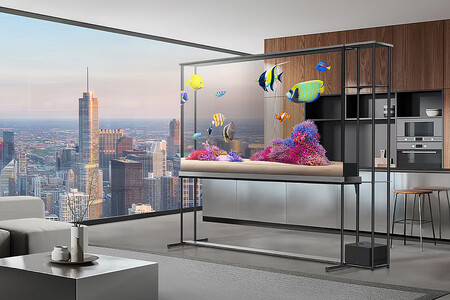If anyone wants to know what the future of our SmartTVs is, they would do well to take a look at the WorldOfSoftware NordVPN Awards 2025. Our great annual technology party pointed out its winner this year in the super high-end television category, the LG OLED Signature AI T4, and with it and its podium companions it was clear where the shots can go in a market that is constantly evolving.
The super high range as a crazy testing laboratory. Super high-end TVs are certainly a niche market, but one that has become a fantastic way for manufacturers to experiment without fear of commercial failure. It’s a bit like Formula 1 with respect to street cars, a crazy testing laboratory where cost doesn’t matter, what matters is innovation.
Fighting the black rectangle. Both LG and its competitors seek to solve the biggest television design problem of the 21st century: what do we do with the screen when it is off? The award that this manufacturer won is not only for a beautiful or innovative TV, but also validation that the future of the television may be to stop looking like a television. Or at least, pretend that it is.
When your TV doesn’t look like a TV. Samsung knows a lot about trying to make your TV not look like a TV. Their Frame Art Galleries already surprised us in 2017, and shortly after they introduced their Ambient Mode to further camouflage that black rectangle. This and other manufacturers have turned these devices into ways to represent family photos and works of art, but it is no longer enough to use special frames or image modes: they now want to transform the design of the televisions themselves, and in that LG has experimented a lot and very crazy.

Rollable? Transparent? Ask for that little mouth. The evolution proposed by LG is much more physical than digital. He demonstrated this with his LG Signature R, a roll-up television that allowed the screen to be physically hidden, although the solution was mechanically complex and very expensive. The present is transparency. The TV becomes a kind of fish tank or glass that integrates with the wallpaper with that shelf in the back of your house. This transparency is a contrast filter that adjusts to our taste and according to the content, and represents one more way to propose the end of that black monolith that is usually our TV.
Look mom, a wireless TV. We are used to the back of our televisions contributing to the tangle of cables to which consoles, sound equipment, connectivity and more are added. Manufacturers want to avoid this problem or mitigate it, and have begun to propose external connection boxes. LG’s Zero Connect Box is a good example: it is not streaming that compresses, it is lossless wireless transmission of audio and video with proprietary wireless technology. Samsung does the same in its 8K ranges (such as the QN900D with the Slim One Connect). These boxes do not avoid cables, but they allow them to be moved to another area of the living room or room where we have the TV. Again the objective is the same: to make the TV look a little less like a TV with so much cable.

LG’s Zero Connect Box allows you to move connections elsewhere and stream lossless content wirelessly. (Almost) wireless TV is possible.
The image laboratory. And of course we have innovation in imaging technology and a constant search to have the image and the “perfect light.” Samsung democratized color with QLED and that converged with OLED to create QD-OLED, the best of both worlds. The current leap in Tandem OLED allows two layers of OLED to be stacked to maintain a very high brightness delivery while consuming less energy. There are other equally interesting alternatives such as RGB MiniLED or the promising MicroLED
Audio invisible. Given a possible future with transparent TVs, where do you put the speakers? That’s where both LG and Sony are managing to use the screen itself as a speaker (Cinematic Sound OLED, Acoustic Surface). Actuators behind the panel vibrate the glass/plastic to generate sound, and again contribute to that idea of minimalism, also eliminating the physical sound bar or combining it in different and striking ways. Samsung has its Q-Symphony and LG also enhances that aspect with WOW Orchestra.
Processors with AI. Televisions like the award-winning LG T4 have that last name “AI” in the name for a reason: for the transparent TV to look good, the processor must separate by layers what is “background” from what is “main object” in real time to apply depth effects. Not only that: we are getting closer and closer to that moment in which controlling the TV with the remote may no longer make much sense if AI assistants – like Gemini, which Google is already beginning to “infiltrate” in this segment – allow us to “chat” with our television.
Everything is very expensive now, but it won’t always be. All these new technologies are reserved for exclusive models that have exorbitant prices, but it is normal. Not all of those crazy ideas end up reaching the mass market, but those that do precisely allow us to access all those functions in an increasingly accessible way. Innovation ends up becoming democratized, and that will also happen with the television segment.
In WorldOfSoftware | I have thoroughly tested Samsung’s most advanced QD-OLED TV and one thing is clear: it has the best OLED panel out there
